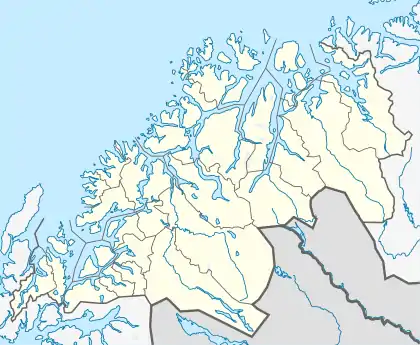Kvænangsfjellet
Kvænangsfjellet (Kven: Naavuononvaara[2]) is a line of mountains along the border of the municipalities of Kvænangen and Nordreisa in Troms og Finnmark county, Norway. The European route E6 highway traverses the mountains through a mountain pass between the Oksfjorden in the west to the Kvænangen fjord in the east. In the winter, route E6 is closed for 10 to 15 days due to snow storms. A short stretch of the route is exposed to the weather, a gap near the route's highest point, at 402 meters (1,319 ft). During the Second World War, the German occupation authorities built a wooden superstructure approximately 6 kilometers (3.7 mi) long using labor from the Veidal Prison Camp to protect the route. The structure was destroyed in scorched earth tactics when the Germans withdrew to the south in 1944.[3][4]
| Kvænangsfjellet | |
|---|---|
 Kvænangsfjellet Location of the mountain  Kvænangsfjellet Kvænangsfjellet (Norway) | |
| Highest point | |
| Coordinates | 69.9001°N 21.5566°E[1] |
| Geography | |
| Location | Troms og Finnmark, Norway |
The Gildetun Inn (Norwegian: Gjestehuset Gildetun) is located along the E6 road that crosses the Kvænangsfjellet. It offers accommodation and meals during tourist season.[5] It is located at a vantage place where tourists are able to photograph the mountain and fjord landscape. It also has a taxidermy display of local birds and other animals.
The Kvænangsfjellet area is used in the summer by Sami reindeer herders.[6]
Gallery
 Storbukttind (literally, 'Big Bay Peak'; 1,054 meters or 3,458 feet) stands just west of route E6.
Storbukttind (literally, 'Big Bay Peak'; 1,054 meters or 3,458 feet) stands just west of route E6. The road over Kvænangsfjellet in April.
The road over Kvænangsfjellet in April. Kvænangsfjellet ski area, east of route E6.
Kvænangsfjellet ski area, east of route E6.
References
- "Kvænangsfjellet" (in Norwegian). yr.no. Retrieved 2018-06-17.
- "Kvensk stedsnavndatabase: Naavuononvaara".
- Pedersen, Guttorm (2013-10-05). "Her bygger tyskerne tunnel over hele Kvænangsfjellet". Nordlys.
- Steffenak, Einar Kr. (2008). Russerfangene: sovjetiske krigsfanger i Norge og deres skjebne. Oslo: Humanist forlag. p. 89.
- "Gildetun Inn". Archived from the original on 2016-10-13. Retrieved 2015-10-17.
- "Indigenous Groups, National Minorities and Cultural Remains". Directorate for Cultural Heritage. Archived from the original on 2015-07-18. Retrieved 2015-10-17.